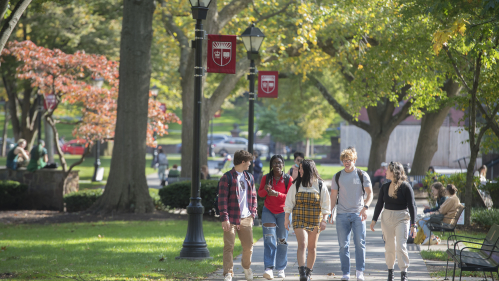Rutgers University Student Voting Rates Increase in 2020 Election

Rutgers student voter turnout increased dramatically over the past four years, following a nationwide trend that began in 2016 and jumped even higher during the 2020 presidential election.
The increase was driven by voter mobilization programs and universitywide collaboration efforts, despite changes to registration and voting processes during the COVID-19 pandemic that made it more difficult to vote.
“Students faced unprecedented obstacles in casting their ballots for the 2020 presidential election due to the pandemic,” said Elizabeth C. Matto, an associate research professor and director of the Center for Youth Political Participation (CYPP) at the Eagleton Institute of Politics. “The student voting data illustrate that our students understood the importance of being engaged in our nation’s democratic process and that they remained motivated to participate in the election despite the state-by-state changes to voting processes.”
Voter turnout rates increased dramatically on all of Rutgers’ campuses. The percentage of eligible students who voted on Election Day increased from 53 percent to 73 percent on the Rutgers-New Brunswick campus; 59.7 percent to 72.4 percent at Rutgers-Camden; and 50.7 percent to 65.7 percent at Rutgers-Newark.
“At this pivotal time in our nation with so much riding on the legacy of those who have fought for our right to cast ballots, the rise in voting among Rutgers students in 2020 is heartening and encouraging,” said Rutgers President Jonathan Holloway. “The increased involvement of our students shows the work led by Eagleton’s Center for Youth Political Participation and other voting rights advocates must continue to drive even greater participation in all elections.”
According to the report “National Study for Learning Voting and Engagement,” published by the Tufts University-based Institute for Democracy and Higher Education (IDHE), Rutgers’ student voting rate was comparable with the nationwide average, which was 66 percent for other higher education institutions. The IDHE analyzed the voting patterns of more than 9 million students on 1,051 campuses nationwide.
The percentage of voting-eligible students who registered to vote increased from 73.5 percent in 2016 to 83.6 percent in 2020 at Rutgers-New Brunswick; from 76.4 percent to 85.4 percent at Rutgers-Camden; and from 66.9 percent to 78.7 percent at Rutgers-Newark.
The CYPP spearheaded voting efforts at Rutgers-New Brunswick and expanded its RU Voting Rutgers program to a nationwide initiative to equip students with information about how to register to vote, how to vote by mail and how to find their polling locations. Through the national program, the center helped those learning remotely during the COVID-19 pandemic by providing timely election information and helping students navigate voting practice changes. The center's efforts were in collaboration with the New Brunswick Civic Engagement Coalition, a campuswide initiative with the Division of Student Affairs and NJPIRG.
In Camden, students formed the RU-C Votes Coalition – which included the Office of Civic Engagement, NJPIRG, Student Governing Association (SGA), the political science department and Rutgers Law School – to coordinate different voting efforts. The coalition organized a biweekly registration table staffed by civic scholars, NJPIRG and SGA. RU-C Votes Coalition held a voter registration fair and used Rutgers’ in-app messaging and other platforms to encourage students to take the pledge to vote.
Rutgers-Newark reactivated its Ballot Bowl Committee comprised of the Office of Student Life and Leadership, NJPIRG, Student Governing Association, and other student organizations to streamline voter engagement efforts. The committee mobilized efforts to register new voters and increase voter turnout through in-person and virtual programs focused on Constitution Day, National Voter Registration Day, National Voter Education Week, Election Day and tabling events, social media campaigns and phone banking.
The data reflect the effect of the pandemic on the voting practices of students nationwide. Eighty-six percent of Rutgers-Newark students did not vote in person in 2020 (compared to 5 percent in 2016), 88 percent of Rutgers-Camden students did not vote in person (compared to 7 percent), and 90 percent of Rutgers-Brunswick students did not vote in person (compared to 12 percent).
The report highlights the increase in voting rates among Rutgers’ youngest students. The voting rate for Rutgers-New Brunswick students ages 18 to 21 rose from 45 percent in 2016 to 66 percent in 2020, from 40 percent to 58 percent for Rutgers-Newark, and from 55 percent to 69 percent for Rutgers-Camden students.


